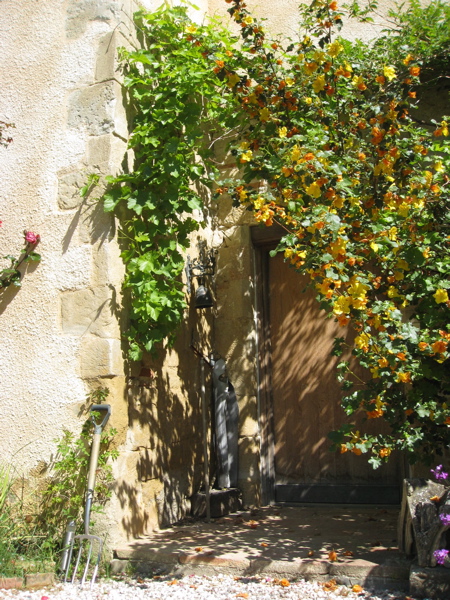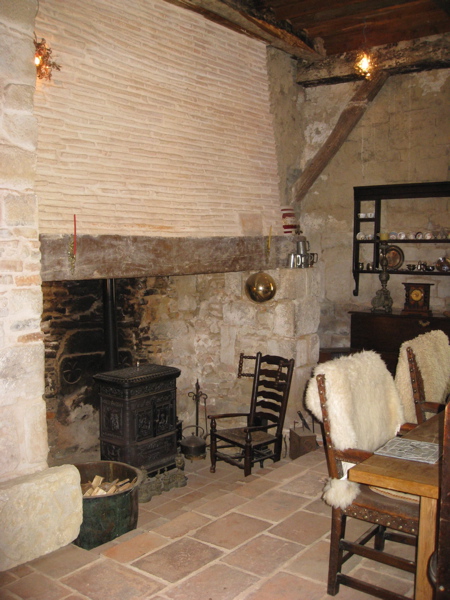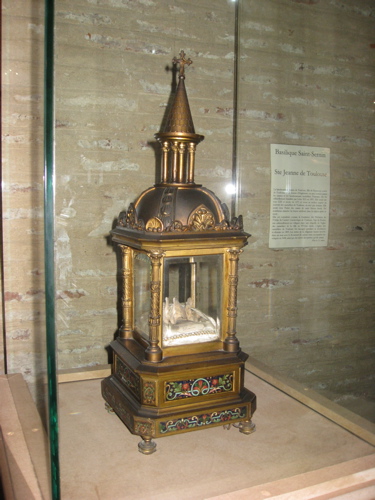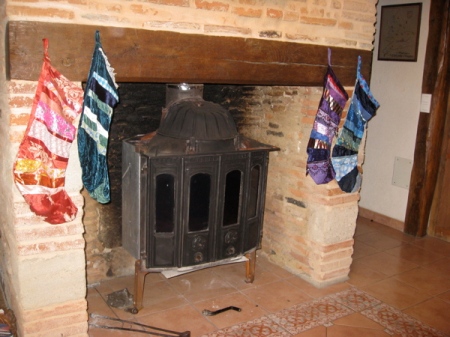When you move into a house that has been around since 1100, sitting on a patch of the Earth inhabited for about 25,000 years, you assume there might be a few ghosts about. Plenty of people have lived in the château Latour; it’s likely that some of those inhabitants or visitors died here. And just perhaps some of that matter or energy that made up those humans has hung around.
It’s not so much that I believe in ghosts, but more that I try hard not to succumb to the all-too-human arrogance that asserts absolute understanding. The universe is mysterious. We simply do not know everything. Galileo is a great example, denounced to the Roman Inquisition, tried, convicted of heresy and sentenced to house arrest in the 1600s for the mere suggestion that the Earth was not the center of the universe. We’ve been wrong before. I try to keep a mind open to possibilities. This, of course, is both helpful and problematic when you’re a writer. Too many possibilities leads to writer’s block or a prose so scattered no one can follow, but a mind closed to possibility can never be the mind of a fictionist. My characters and stories grow from my imagination, often in a way that seems mysterious. Sometimes I almost hear voices. Sometimes I can see a whole scene or character, or hear a conversation, that exists—I think, but am not certain—only in my head. Sometimes the words and stories come with so little effort that it seems like magic. Explain it with psychology or biology or history. Call it madness or divine inspiration or demonic possession. Call it mystery or magic. I can’t explain it, but sometimes the fiction seems a kind of haunting.
We moved up to the tower apartment on October 21, Halloween Day, so I asked Pete and Rosie for a good ghost story. They told me about the phantoms with whom they share Latour des Feuilllants.
First is the white-robed man with the square hat who is most often encountered on the fifty wooden steps in ten flights up to a tower that originally served as a look-out across the hills and valleys for marauders, invaders and other dangers on one of the many Roman roads that cross this part of France. Both Pete and Rosie have seen him numerous times, Pete most clearly in an evening encounter at the first floor landing. Some time later, in his reading of the history of the monks who were the original inhabitants of the chateau, Pete discovered an illustration that matched the costume he had observed in his encounter: a man in a square white hat with robes nearly to the floor, identified as a “first visitor” or cleric who would have been sent out from the Vatican to check up on country estates like this one, owned by the Church and manned by the monks from monastery outposts. This spirit is not malicious, Pete says, but a gentle watchman who drops by to check up on things from time to time.
Chained outside the front door is a couple from around the 1400s, more traditional sorts of ghosts. The gruesome story goes like this. The master of the house, as was common in those days, exercising his “droit de seigneur,” got a serving girl pregnant. When she gave birth, the master and mistress—the couple chained outside—threw the girl and her newborn into the big fireplace in the formal dining room. These evil-doers, the story goes, are condemned to a long tenure stuck on earth. But they are outside, we’re assured, not permitted to enter.
There are often unexplained smells—of baking, often—and sounds in the château. Occasionally something like a piece of paper will move, just slightly, without explanation. The monks buried their own on the property, just outside the wall, so some of those fellows may be wandering about as well. Pete says he feels he’s being watched quite often as he works about the garden and orchard. Sometimes he talks to the ghosts. Maybe that’s a little like me when I write. Talking to ghosts.
How do Pete and Rosie know these details about the ghosts? Early on in their ownership of the house, a guest—a French garage mechanic—came down to breakfast after his first night having slept terribly. He explained. “There was this terrible heavy weight on my chest all night.” He slept in the same room in which Susan and I slept when we first arrived in Saint Araille. Susan—a sponge for feelings and emotions in the ordinary world—suffered a week of disturbing dreams there, “bloody” and violent dreams, as she described them. Izzy too, sleeping in the bedroom at the other end of that apartment, had bad dreams those first weeks. We had chalked it all up to the newness of the situation. The change in our lives. Now we reconsidered our psychological explanation.
In addition to being a mechanic, the Frenchman was a psychic—apparently a quite well-known one—and he offered to exorcise the chateâu for Rosie and Pete. They agreed, and followed along as he performed the task. As the mechanic/psychic and his friend (another psychic) moved from room to room and floor to floor in the château, he told them what he saw, who he encountered, a little of the ghost’s history. His friend kept asking questions like, “who is that?” Or “why do I hear a baby crying?” As they proceeded, stable to breakfast room to dining room, salon and up through the building, he sprinkled holy water, prayed, and, finally, gathered the spirits together and then released them to rise to heaven. At that point, Pete became suddenly so cold that he had to leave and go sit by the fire. The psychics left soon after, to go to Lourdes to replenish their supply of holy water, and the woman said that as they looked back at the château on the hill, they could see a mist rising toward the sky. All the drive to Lourdes, their car was under a bright patch of sun, “illuminated” though it was a cloudy day.
I’ve never seen a ghost, never experienced the things Rosie and Pete describe, exactly. But I kept my eyes open all winter, all those long trips up and down the stairs to take the dogs out in the darkness, ready for an encounter with the white-robed first visitor. I never saw him. I did feel nervous, spooked even, quite a few times. The château was huge for our little family of four and the two dogs, and because we kept ourselves primarily up in our tower apartment, the rest of the house was cold, dim and dusty. If ever there were a place for ghosts, this is it.
In March, Pete and Rosie returned from New Zealand, and Spring arrived. Doors and windows and shutters were flung open, the daylight hours lengthened, and the house became more lively. More filled with life. Anything ghost-like seemed to fade back into the few shadows.
Then Susan strained her back, leaving her in agonizing pain for several weeks. The best mattress in the apartment is on a small twin-sized cot up in the loft at the very top of the tower, next to the double bed in which Izzy sleeps. Susan began sleeping on that firm bed in the loft, which is windowless except for one skylight and the glass door that opens onto the porch overlooking the countryside. The weather changed around then. Cold, wet winds blew in from the west and the Atlantic Ocean. We tucked in around the wood stove in the evenings until bedtime.
One morning after the kids were delivered to school, Susan said, “I almost forgot to tell you. I saw ghosts last night.” Very late she had woken and seen several reddish glowing figures around the loft. At least four and maybe as many as a half-dozen. “I was plenty awake enough to know that what I was seeing wasn’t a dream,” she said. “I tried to think of what it might be. A plane going over? No. It was dark out, overcast. There were no lights on in the house.” The figures were just there, presences, wavering a little. “It was really weird,” she said. “Definitely something there.” Eventually they went away, but she was spooked and didn’t sleep well the rest of the night. Two nights later, she had a much more intense experience. She woke to find a reddish light form right next to her bed. A sound like static or a humming. In the middle of the form, she saw a sepia-toned series of scenes, like a silent movie on fast-forward. She saw women wearing long dresses and scarves and men, peasants she thought, harvesting hay or grain and throwing it onto a wagon. Scenes from a life, she thought, a long time ago. There didn’t seem to be any malice in the ghost, but intensity, she said, as if the ghost really needed her to see this. A witness to a life, perhaps. Again, it eventually disappeared. After that, until her back healed, Susan willed the spirits to stay away, telling them before going to sleep that she wasn’t willing to see them now. We have had no ghostly encounters since then.
Are we haunted? Who knows?
This is what I do know. Ghosts have crept into almost everything I’ve written since Susan’s encounter—a long short story, this essay, a whole new novel for teens set here in the château. I am fascinated by the idea (though not the actual experience; I’d just as soon not see any ghosts). Why do we see or imagine ghosts? What do these fantasies or fantômes or fears have to tell us? Are our unconscious minds communicating something we need to recognize or know or learn about our own lives? Do we simply frighten ourselves by contemplating the vast unknown in the universe? Is some matter or energy or spiritual being trying to lead us astray or toward some celestial epiphany? Or is it merely that we humans live consumed by the importance of our individual lives, which, it turns out, are relatively insignificant.
Here in Latour des Feuillants, I am conscious, daily, of the fact that in this very spot have likely lived and died thousands of other individuals: prehistoric cave painters, Roman soldiers and travelers, monks and peasants, wealthy lords of the manor, extended farming families, World War II resistance fighters and twentieth century bed and breakfast owners. Twenty-five thousand years of single all-consuming human lives. As I consider Susan’s haunting, the intensity of that ghost who needed to have his or her life witnessed, remembered, counted, I think I better understand my own fictional hauntings. These lives and stories and people who appear—apparitions—in my mind and become physical on the page, whether they are subconscious parts of myself or some mysterious others, are a most important magic. The writing, for me, is a kind of manifestation of existence. With the words, I try to witness the vitality and mystery and humble reality of a single, simple human life. And in the end, I suppose, this too becomes a kind of ghost.




